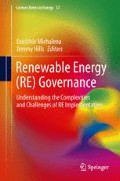Abstract
This chapter deals with the governance of renewable energy in Norway. The Norwegian case is a peculiar one. Norway has been blessed with an abundance of waterfalls, which for the past 100 years have been used to produce cheap and renewable electricity. In addition, Norway has vast oil resources which have been exported to generate national wealth. How does Norway’s odd position of on the one hand being one of the most renewable nations in Europe, while fuelling the world with hydrocarbons affect the governance of ‘new’ renewables? Does the fact that Norway is already one of Europe’s largest producers of renewable energy make a transition toward more renewable policy and production, easier or harder? What cultural, political, and financial factors seem to influence Norway’s strategies in the area of renewable energy production? Historically, energy in Norway has been both cheap and profitable, and Norwegian energy policies have traditionally been geared toward this goal: energy use and production should first and foremost be cost-effective. This situation has been challenging for the implementation of new renewable energy technologies. In the liberalized Norwegian electricity market, the governance of renewable energy has largely been left in the hands of the market participants. The low electricity prices over the past years have not attracted investment in renewables. In an attempt to mitigate this, Norway recently introduced electricity certificates in a joint market with Sweden, thereby creating a new class of incentives for investment in renewable energy generation. Further, to increase Norwegian renewable energy deployment, the Norwegian government has funded research and development projects and a number of large research centers for environmentally friendly technologies. However, there appears to be challenges in transferring the R&D activities to commercial products that could reach the market.
Access this chapter
Tax calculation will be finalised at checkout
Purchases are for personal use only
References
Adomaitis N (2012) Norway’s ambitious plans to boost wind power output to cut greenhouse gas emissions and diversify supplies are at risk because of low power prices and an underfunded subsidy scheme, industry sources say. Reuters
Aune M (2007) Energy comes home. Energy Policy 35(11):5457–5465. doi:10.1016/j.enpol.2007.05.007
Aune M, Ryghaug M, Godbolt ÅL (2011) Comfort, consciousness and costs—transitions in Norwegian energy culture 1991–2010. Energy efficiency first: the foundation of a low-carbon society. In: Proceedings of the ECEEE 2011 Summer Study
CenBio (2012) Cenbio—bioenergy innovation centre. Available via http://www.sintef.no/Projectweb/CENBIO/
Devine-Wright P (2009) Rethinking NIMBYism: the role of place attachment and place identity in explaining place-protective action. J Comm Appl Soc Psychol 19(6):426–441. doi:10.1002/casp.1004
Geels FW (2004) From sectoral systems of innovation to socio-technical systems: insights about dynamics and change from sociology and institutional theory. Res Policy 33(6–7):897–920. doi:10.1016/j.respol.2004.01.015
Gjerald OI (2012) Fornybare strategiar? Innovasjon, implementering og kommersialisering for ny fornybar energi. Vestlandsforskning, Sogndal
Hansen GH, Steen M (2011) Vindkraft til havs. Teknologi-og industriutvikling fra et norsk bedriftsperspektiv. Trondheim, CenSes
Hanson J (2011) Innmatingstariffer—marked som læringsarena. In: Hanson J, Kasa, S, Wicken O (eds) Energirikdommens paradokser. Innovasjon som klimapolitikk og læringsutvikling. Oslo, Universitetsforlaget
Karlstrøm H (2010) Den deregularte forbruker. Norske strømforbrukeres holdninger til strømmarkedet, fornybar energi og bærekraftig kraftproduksjon. NTNU, institutt for tverrfaglige, kulturstudier
Karlstrøm H (2012a) Empowering markets?: the construction and maintenance of a deregulated market for electricity in Norway, vol 79. Trondheim, Norges teknisk-naturvitenskapelige universitet
Karlstrøm H (2012b) Norge—Europas Grønne Batteri. Manifest tidsskrift
Kasa S (2011) Klimakamp blir innovasjonspolitikk. In: Hanson J, Kasa, S, Wicken O (eds) Energirikdommens paradokser. Innovasjon som klimapolitikk og læringsutvikling. Universitetsforlaget, Oslo
KRD (2008) Ot.prp. nr. 45 Om lov om planlegging og byggesaksbehandling (plan- og bygningsloven) (byggesaksdelen). Ed. Ministry of local and regional development
NORCOWE Vision (2012) Available via http://norcowe.no/index.cfm?id=229099
NOU (2006) Norges offentlige Utredninger 2006: 18. Et klimavennlig Norge
OED (2006) St.meld. nr. 11 (2006–2007). Om støtteordningen for elektrisitetsproduksjon fra fornybare energikilder (fornybar elektrisitet). Ed. Ministry of petroleum and energy
OED (2008) Strategi for økt utbygging av bioenergi. Olje- og Energidepartementet
Rosenberg N (1994) Exploring the black box. Technology, economics and history. Cambridge University Press, New York
Rygg B (2012) Local governments’ engagement with bioenergy. Paper given at Innovation and learning in energy policy: new pathways to sustainability. Trondheim, December 12–14, 2012
Ryghaug M, Sørensen KH (2009) How energy efficiency fails in the building industry. Energy Policy 37(3):984–991. doi:10.1016/j.enpol.2008.11.001
Skjølsvold TM (2012) Towards a new sociology of innovation: the case of bioenergy in Norway and Sweden, Norwegian University of Science and Technology, Faculty of Humanities, Department of Interdisciplinary Studies of Culture, Trondheim
SSB (2011) Fjernvarmestatistikk 2010. Sterk økning i fjernvarmeforbruket. Statistics Norway, Oslo. Available via http://www.ssb.no/fjernvarme/
Sørensen KH (2007) Fra “hvite kull” til grønn varme? Utfordringer for energi. In: Sørensen KH, Aune M (eds) Mellom Klima og komfort. Utfordringer for en bærekraftig teknologiutvikling. Tapir Akademisk Forlag, Trondheim
Tamnes R (1997) Oljealder. 1965–1995, Norsk utenrikspolitikks historie. Universitetsforlaget, Oslo
UNDP (2011) Human development report 2011. sustainability and equity: a better future for All
Author information
Authors and Affiliations
Corresponding author
Editor information
Editors and Affiliations
Rights and permissions
Copyright information
© 2013 Springer-Verlag London
About this chapter
Cite this chapter
Skjølsvold, T.M., Ryghaug, M., Dugstad, J. (2013). Building on Norway’s Energy Goldmine: Policies for Expertise, Export, and Market Efficiencies. In: Michalena, E., Hills, J. (eds) Renewable Energy Governance. Lecture Notes in Energy, vol 23. Springer, London. https://doi.org/10.1007/978-1-4471-5595-9_20
Download citation
DOI: https://doi.org/10.1007/978-1-4471-5595-9_20
Published:
Publisher Name: Springer, London
Print ISBN: 978-1-4471-5594-2
Online ISBN: 978-1-4471-5595-9
eBook Packages: EnergyEnergy (R0)

